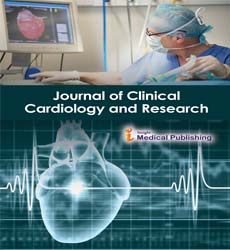Vascular Imaging Approach to Acute Mesenteric Ischemia: Role of CTA in Rapid Diagnosis
Lydia Batuhan
Department of Cardiology, Attikon University, National and Kapodistrian University of Athens, Athens, Greece
Corresponding author:
Lydia Batuhan,
Department of Cardiology, Attikon University, National and Kapodistrian University of Athens, Athens, Greece;
Email: lydia@batuhan.gr
Received date: January 01, 2025, Manuscript No. ipccr-25-20608; Editor assigned date: January 03, 2025, PreQC No. ipccr-25-20608 (PQ); Reviewed date: January 15, 2025, QC No. ipccr-25-20608; Revised date: January 22, 2025, Manuscript No. ipccr-25-20608 (R); Published date: January 28, 2025, DOI: 10.36648/.8.5
Citation: Batuhan L (2025) Vascular Imaging Approach to Acute Mesenteric Ischemia: Role of CTA in Rapid Diagnosis. J Clin Cardiol Res Vol.8 No.1:5
Introduction
Acute Mesenteric Ischemia (AMI) represents a vascular emergency where timely diagnosis is critical to survival. Clinical manifestations are often vague, with â??pain out of proportionâ? to examination being a classic but nonspecific clue. Radiology, particularly contrast-enhanced Computed Tomography Angiography (CTA), has emerged as the cornerstone in early detection by accurately localizing vascular occlusion, assessing intestinal viability, and identifying complications that dictate urgent surgical or interventional management. The integration of radiological findings with clinical suspicion provides a decisive pathway in this high-mortality condition [1].
Description
In this case, an elderly patient with atrial fibrillation presented with acute severe peri-umbilical pain, nausea, and minimal tenderness. Laboratory evaluation revealed leukocytosis and elevated lactate levels, raising high suspicion for AMI. A biphasic CTA covering the abdomen and pelvis was performed, revealing an abrupt intraluminal filling defect in the superior mesenteric artery (SMA) approximately 2 cm distal to its origin, characteristic of embolic occlusion. The downstream jejunal loops demonstrated reduced mural enhancement, mild dilation, and sluggish mesenteric venous opacification, consistent with ischemic injury. No evidence of pneumatosis intestinalis or portal venous gas was seen, although mild mesenteric edema and a small ascitic collection were present [2]. Radiological differentiation was critical, as embolic AMI is distinguished by an abrupt vascular cutoff in a normal proximal vessel, while SMA thrombosis typically presents with tapered attenuation due to underlying atherosclerosis. Mesenteric venous thrombosis is characterized by central venous filling defects with bowel wall stratification, whereas non-occlusive mesenteric ischemia presents with patent but vasoconstricted vessels and diffusely reduced enhancement. The CTA pattern in this case strongly favored embolic AMI [3]. The portal venous phase confirmed lack of reperfusion and allowed evaluation for prognostic markers, further refining clinical decision-making. Management was directly informed by imaging findings. The absence of transmural infarction or perforation allowed for an endovascular-first approach, with urgent SMA catheterization, aspiration embolectomy, and limited thrombolysis. Radiology also defined surgical thresholds [4]. Including non-enhancing paper-thin bowel walls, pneumatosis or portomesenteric gas, and perforation. Planned radiological reassessment at 24â??48 hours provided a structured follow-up to monitor bowel viability and detect evolving complications This approach demonstrated how imaging-guided algorithms can refine therapeutic decision-making in complex vascular emergencies. By delineating both the extent of ischemia and the absence of irreversible damage, radiology enabled a minimally invasive intervention that preserved bowel integrity while reducing surgical risk The structured reassessment protocol ensured that evolving complications were identified at an early stage, facilitating timely escalation to surgery if required [5].
Conclusion
This case demonstrates that multiphasic CTA is indispensable in the evaluation of suspected AMI, offering precise determination of the underlying mechanism whether embolic, thrombotic, venous, or non-occlusive while simultaneously guiding therapeutic decisions. A structured radiological report emphasizing the site of occlusion, bowel wall enhancement, presence of ischemic markers, and associated mesenteric changes is vital for effective communication with clinicians and for ensuring timely organ-preserving intervention.
References
- Ghaben AL, Scherer PE (2019) Adipogenesis and metabolic health. Nat Rev Mol Cell Biol 20: 242–258
Google Scholar Cross Ref Indexed at
- Man AWC, Zhou Y, Xia N, Li H (2023) Perivascular adipose tissue oxidative stress in obesity. Antioxidants 12: 1595
Google Scholar Cross Ref Indexed at
- Bartuskova H, Kauerova S, Petras M, Poledne R, Fronek J, et al. (2022) Links between macrophages in perivascular adipose tissue and arterial wall: A role in atherosclerosis initiation? Int Angiol 41: 433–443
Google Scholar Cross Ref Indexed at
- Hwang I, Kim JB (2019) Two faces of white adipose tissue with heterogeneous adipogenic progenitors. Diabetes Metab J 43: 752–762
Google Scholar Cross Ref Indexed at
- Shore A, Karamitri A, Kemp P, Speakman JR, Lomax MA (2010) Role of Ucp1 enhancer methylation and chromatin remodelling in the control of Ucp1 expression in murine adipose tissue. Diabetologia 53: 1164–1173
Open Access Journals
- Aquaculture & Veterinary Science
- Chemistry & Chemical Sciences
- Clinical Sciences
- Engineering
- General Science
- Genetics & Molecular Biology
- Health Care & Nursing
- Immunology & Microbiology
- Materials Science
- Mathematics & Physics
- Medical Sciences
- Neurology & Psychiatry
- Oncology & Cancer Science
- Pharmaceutical Sciences
